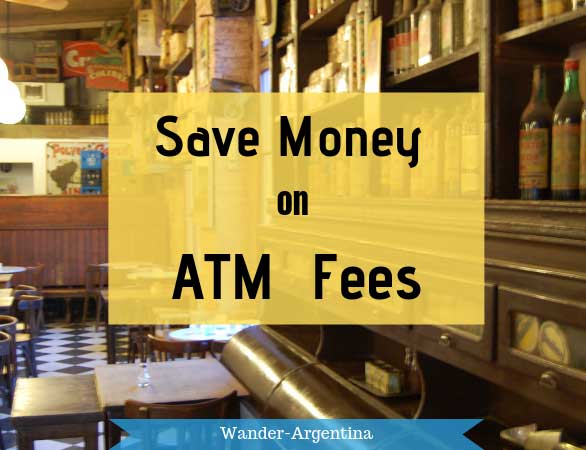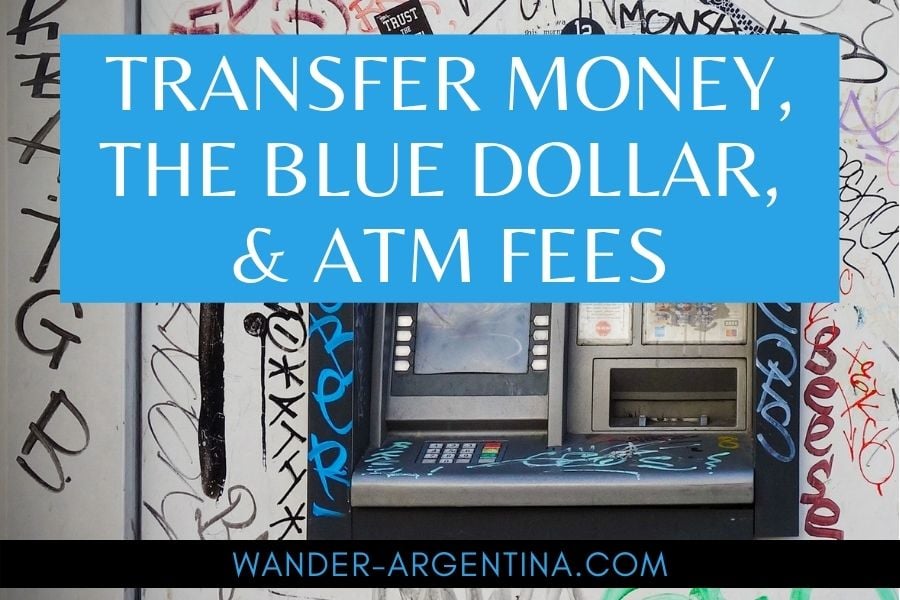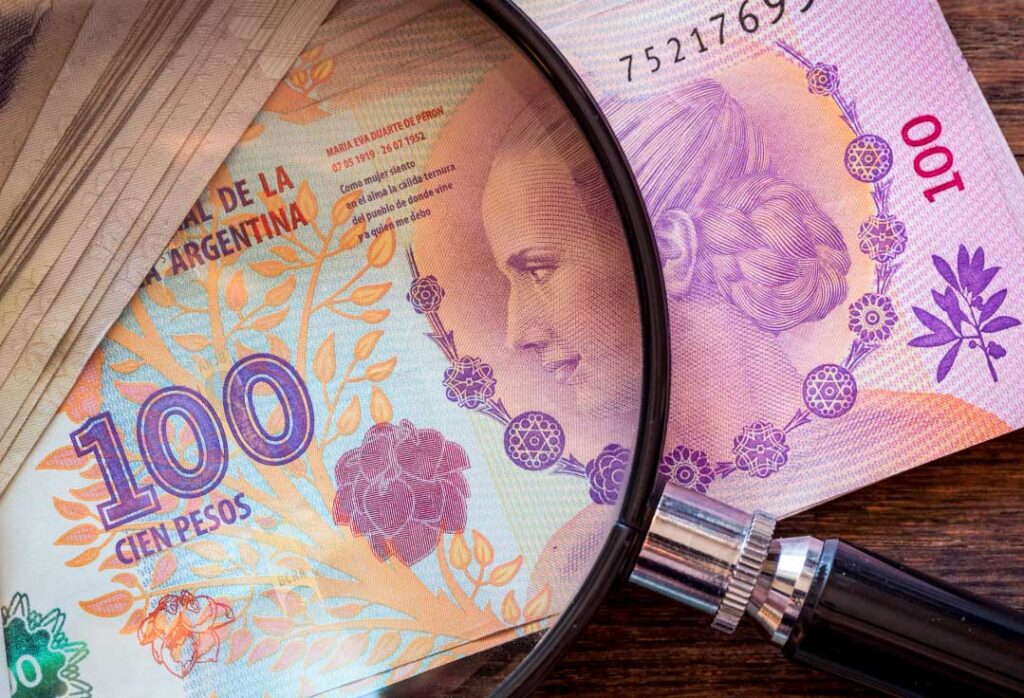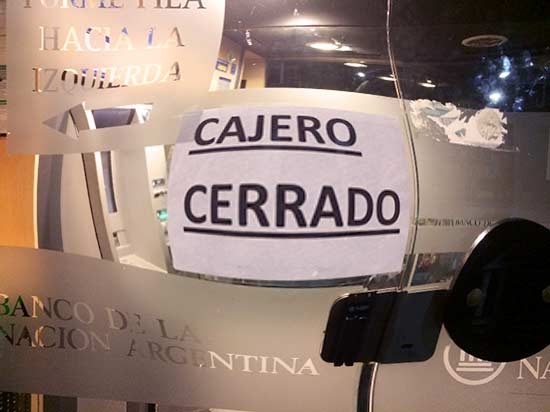In Argentina, managing your money often means navigating through a complex landscape of exchange rates, making the task of obtaining a good rate a concern for visitors.
Carrying large amounts of cash or ‘Blue Dollars’ can be cumbersome and poses its own set of challenges, such as exchanging on the black market.
A good alternative is the electronic transfer of money to oneself, usually via Western Union.
This method not only avoids the inconvenience and safety risk of carrying physical cash but also offers the potential to secure favorable exchange rates. (➡ Read some general safety tips.)
Even if you’ve never considered using services like Western Union before, it’s worth exploring why this method has become a popular choice for foreigners looking to access pesos at a fair rate.
Read on to discover why Western Union still is a major option to access money for travelers to Argentina.
Blue (Dollar) is Still a Thing!
Getting a grasp on Argentina’s unique economy is important for budget-conscious travelers headed to Argentina.
If you don’t know about the ‘Blue Dollar’ or ‘Dólar Blue‘ read on because it can make a huge difference in how much you eventually end up spending on your trip to Argentina.
‘Blue Dollar’ is an euphemism for the black market exchange for U.S. dollars, which is created by the government’s own policies to manipulate the currency market.
V&S Boutique Hostel is a place to stay that ticks all the boxes.
It’s reasonably priced, clean, and offers guests a wide range of activities.
It is also located in the thick of the action downtown — this could be either a plus or a minus, depending on what you’re after.
This post includes affiliate links. If you make a booking we receive a small commission at no extra cost to you ❤️.
A Laid-Back but Social Downtown Hostel
Most Buenos Aires hostels are gathered around the tango bars and steak houses of San Telmo, or the bars and clubs of Palermo, but the microcentro area offers a happy compromise.
The corner of Viamonte and Suipacha streets lies two blocks walking distance of the pedestrian thoroughfare of Florida and Galeria Pacificos, a shopping mall that contains the Borges Cultural Center.
It’s also two blocks away from the spectacular Teatro Colón, among the world’s most celebrated opera houses.
Transportation is no problem here with numerous bus stops and subway lines running nearby.
Getting to San Telmo from the V&S takes less than 30 minutes on foot, and is even quicker by public transport or by using one of the city’s free bikes.
Palermo is slightly further away but still easy to reach from here.
The only drawback of being based downtown is the noise and hustle of a typical working day, which confront you as soon as you step out the door.
If you can cope with that, you’re in a very convenient spot for a fun stay in Buenos Aires.

Discover Argentina’s Asado Tradition in a friendly, fireside atmosphere.
The Space: Peaceful but Social
Inside, the V&S is relaxed and comfortable.
Typical Argentine early 20th-century elegance is reflected in details such as the antique elevator, the cozy library and the French balconies and terrace overlooking a park.
The communal area is sunny and spacious, decorated with touches of rural Argentina.
It’s also dominated by a gigantic TV, perpetually alternating between movies and sports, depending on who has wrestled control of the remote.
V&S offers all the standard features you would expect from a good hostel.
The price of your room includes a buffet breakfast (until 10:30 am), introductory Spanish and tango lessons, and personal lockers (bring your own lock for extra security).
Internet access and laundry are available for a small fee.
The staff helps arrange trips to the usual attractions such as football games, theater and tango shows.
The management also finds a good balance between encouraging a peaceful environment for guests who need their rest, while providing plenty of opportunities to socialize.
Group dinners are arranged a couple of times a week they can get guests discounts at various recommended nightspots every night of the week.
On Thursday, Friday, and Saturday nights the hostel puts on live shows highlighting Argentine genres of music, such as tango and national rock, giving guests the chance to experience the local scene.
Rates vary slightly depending on season and length of stay, but the cheapest option is the 8-person room.
Four-bed rooms, with either external or internal bathrooms, are a slightly more expensive alternative.
Private rooms for solo travelers or couples with a small balcony and private bathroom are also available.
A huge plus is that all rooms have air conditioning and heating, an important feature during Buenos Aires’ chilly winters and muggy summers.
If you’re looking for a downtown hostel in Buenos Aires, head to V&S for a more relaxed environment.
If partying is on the agenda, check out the nearby Milhouse Hostel on Avenida de Mayo.
Book V&S Hostel Online
Viamonte 887 (corner of Suipacha)
Retiro/Downtown
Argentina has a tumultuous banking history and beginning in late 2019 the country’s unorthodox currency restrictions (which most also existed from 2012-2015) came back with the return of a Peronist party government.
The restrictions place limits on the amount of foreign currency locals can purchase, thus creating a parallel ‘black’ market for foreign currency.
Due to the inflationary nature of the Argentine peso, locals prefer to save in foreign currency because Argentine pesos lose significant value sitting in the bank (or under the mattress, better to have dollars).
The creative currency controls create a huge underground demand for foreign currency since locals also have no way to get their hands on any reasonable amount of foreign currency through official channels.
For travelers to Argentina until recently, this meant that USD (and to a lesser extent, Euros or Reals) is worth more cash-in-hand in Argentina than the official government rate given out at banks and ATM bank machines.
But soon after the new President, Javier Milei took office in late 2023 he heavily devalued the peso as part of a series of ‘shock measure‘ to restabalize the country’s economic woes.
This measure changed the gap between the official rate and the Blue Rate to make it initially 30% instead of 75%.
As of the second month of 2024, Western Union offers a better rate than exchanging greenbacks.
But things are always changing, so read on to learn how to mitigate the ongoing changes.
Luckily visitors can also receive a great rate using some (not all) money transfer services, as you can see by comparing their rates with the official rate.
Using Western Union to Get a Good Exchange Rate
Western Union is the most popular Money Transfer service for foreigners in Argentina because they give a competitive rate and have lots of locations.
Other money services include Moneygram and Remitly, but Western Union dominates the market because of its ease of use, good rates and numerous locations throughout Buenos Aires and cities around the country.
Sign Up for Western Union
If you’re signing up to Western Union for the first time, (or making a new account for some reason 😉) use our link and get a $20 Amazon gift card when you send at least $100.
Sign Up ➡Explaining the ‘Blue Dollar’ for Visitors to Argentina
Welcome to the thrilling adventure of dealing with money in Argentina.
Exchanging currency on the black market is a legal grey area but a common practice for locals.
If you’re planning to visit Argentina and want to exchange money on the black market, keep in mind that USD, Euros, and Brazilian Reales are the only three foreign currencies in demand.
Visitors, just like most Argentines, won’t be able to get foreign currency through legal means within Argentina.
Banks and ATMs only dispense Argentine pesos using ATMs is still avoided by in-the-know foreigners because they have low withdrawal rates and high fees.
While ATMs now give a rate closer to the Blue Dollar, their fees in Argentina can be outrageous, with a 25% fee not being uncommon.
Today, using an electronic money transfer service is still a great alternative option because it is legal and provides a higher rate than withdrawing money from ATMs and sometimes a better rate than exchanging USD on the black market.
But using Western Union can be a chore and can occasionally turn into an odyssey (especially in small town Argentina), so it’s up to travelers to do their own cost-benefit analysis.
The one way that travelers or digital nomads can get their hands on dollars is by hoping to a border country, such as hopping across the river to Colonia, Uruguay from Buenos Aires.
Uruguay’s ATMs give U.S. dollars, but just like with Western Union, make sure you’re not the last in line.
U.S. dollars can also be obtained from some banks in Bolivia. Chile’s ATM’s do not give U.S. dollars.
Make Sure to Carry Cash Too
In practice, the current economic situation in Argentina means it is still largely a cash-only economy for foreigners because most travelers want to get the best rate possible.
To do so, avoid ATM’s (unless you have a card that refunds fees). Either exchange cash to get the Blue Rate or use Western Union.
Those who travel to Argentina with foreign cash can exchange it on the black market, such as on Buenos Aires’ Florida Street or ask your hotel for a ‘cueva‘ (‘cave’) to exchange money nearby.
The Current Black Market Rate: Argentine peso to USD black market rate
All the different rates in Argentina fluctuate but as of January 2024, the official rate is 70% of the Blue Dollar rate.
The breach between the official, blue dollar and credit cards rates fluctuates daily, so be sure to check with method of acquiring money works best for your situation.
Background on Argentina’s Blue Dollar
Argentina had a thriving black market for currency under the second term of Cristina Kirchner from 2012-2015, when visitors could get double the cash on the black market.
In the previous ‘blue dollar’ days, Argentina had a reputation as a budget destination.
As long as in-the-know foreigners brought fistfuls of foreign cash to exchange on the black market, they could enjoy a relatively inexpensive vacation.
Argentina lifted the dollar restrictions and returned to relative normalcy on the banking scene between the years of 2015-2019, while the neoliberal administration of Mauricio Macri was in the Casa Rosada.
During these years, there still existed a small black market for currency but the spread between the official rate and the black market rate was negligible compared to now, so foreigners mostly didn’t bother with it.
One of the first moves of the newly-elected Peronist government returned to power in late 2019, was to reinstate the unorthodox currency restrictions, bringing the country is back to the ‘blue dollar‘.
The restriction on foreign currency made Argentina a budget destination.
Measures put in place by the new President who took office in December 2023 such as devaluing the peso have caused inflation, so in 2024, things are a bit more expensive for everyone.

Saving Money
On Florida Street in downtown Buenos Aires, police officers stand around while ‘arbolitos‘ (money changers) yell out ‘Cambio, Cambio — Dolares, Euros’ to offer their services.
Changing money with a random arbolito (money changer) on Florida Street usually turns out fine.
As a courtesy, we will exchange a small amount of dollars at the Blue Rate, for those using our airport pickup service on the weekends, when there are few people changing money.
Changing Money on the Black, erm, Blue Market
It’s best to be informed about the process of changing on the ‘blue market’ before you go to a ‘cueva‘ (as the underground exchanges are called.)
Visitors should not be confused by legal storefront currency exchange houses around the city — their rates are usually similar to the bank rate, so few people use them.
Either ask a local friend to go with you to exchange money the first time to get a lay of the land, or read our article about ‘arbolitos‘ ‘Money Exchange and Other Hustles on Florida Street.’
Before going to change money at a cueva, look up the live ‘Blue Dollar’ /black market rate on our currency converter or look for the ‘dolár informal’ rate on local newspapers.
Many of the underground exchange houses are on the downtown pedestrian thoroughfare of Florida Street, although they do exist in other areas of the city.
Sometimes the exchanges operate in the back of jewelry or flower stores in Buenos Aires and around the country.
Basically, any business might opt for a little side business changing money, after all most people trying to save money in Argentina need dollars anyway.
If doing it on the fly your first time, just walk down Florida street and when someone offers to change money (and they will, especially if you look like you have dollars in your pocket) ask a few different people the rate.
When a rate seems reasonable, only change money if they take you indoors to the cueva — don’t do it on the street.
Some private individuals come to your home, Airbnb or hotel to change money, but make sure to arrange this only with a trusted contact.
If in a pinch on the weekend or holidays, some supermarkets will also take dollars (only larger bills) if you purchase something.
They will give you the change in pesos, but be sure to check that the rate they offer is closer to the black market rate than the official exchange rate.
Using Electronic Transfer Services to Receive Money in Argentina
Western Union
So what if you didn’t know about the Blue Dollar and/or are already in Argentina with no foreign currency?
This is when Western Union comes to the rescue.
Many people use Western Union, as they give a comparable and sometimes higher rate than the Blue Dollar.
They take a commission of between 5-10% but no one is complaining when you compare their rate to the official rate.
If you’ve never used Western Union before, or are making. anew account, you can get a $20 Amazon gift code by signing up with this link:
How to Sign Up for Western Union
- Go to Western Union’s webpage or download their app
- Make an account from your home country, using the same home address you use for your bank. *Make sure all details on the account are correct (¡important!) Even though the app says it’s optional, problems can occur if the name doesn’t match.
- Press ‘send money’ and select Argentina and yourself as the receiver.
- Go to a Western Union office with your passport and the MTCN number they provide immediately after to get your money
Sign up for Western Union (⬅ and we both get $20 Amazon credit.)When it comes to pulling funds for Western Union, you’ve got three sources to choose from — your trusty debit card, credit card, or bank account.
Each comes with its own unique fee structure.
If you’re all about saving those extra bucks, the bank account is the winner with the lowest fee if you have a local friend whose account you can use.
The downside it usually involves a wait time of four business days, if there are no complications.
If time is of the essence, debit card and credit card options are available with higher fees, but they offer quicker access to your funds.
Be aware that for your first transaction or if you’re using a different funding source for the first time, there might be some additional delay.
We know you might be curious about the exact wait times, but unfortunately, it varies for different people, so that’s why we always suggest having a backup cash reserve.
Receiving Money from Western Union
There are two options for receiving your transaction in Argentina: deposit into a local bank account (if you have one, or a trusted friend’s) or picking up cash at a Western Union office, which are often in offices with a PagoFacil which is where locals pay bills.
If you choose to pick up cash funded by a credit or debit card, you can usually get access to your funds within minutes.
Tips for Western Union
Sometimes people have issues signing up and using Western Union for the first time to send money to themselves in Argentina.
This is because of security checks and international anti-money laundering laws.
For first-time customers, this can result in futile conversations with their chatbots or long waits on the phone.
If you have issues completing the transaction try these hacks:
- Send a smaller amount (under $500) the first time — larger amounts get flagged easier
- Clear your computer cookies and try again
- Call your bank to make sure they aren’t blocking the transaction
- Make sure the address and name attached to your bank account and the WU account are the same (they can be fussy about middle names)
- Try to make the transaction on a different device
- Use a Tor Browser or VPN to sign up and/or make the transaction — the originating IP showing Argentina can cause the transaction to be blocked
- Try to use a different bank account or card — some banks have more sensitive triggers to reject new or unusual transactions than others
- Make two accounts with two different email addresses, one as the sender and one as the receiver (this may seem desperate, but it’s better than the chat bots and you can get another Amazon gift card)
- Although there may be a wait to talk to an agent, often calling Western Union will help you get things worked out.
—Just don’t mention you are sending money to yourself from out of the country as they may want to transfer you or suspect that it is a fraudulent transaction.
Tips for Picking Up Your Money Transfer
Be aware that the worst times to pick up money are late on Friday, Saturday or before a holiday, or the first few days of the month when everyone is trying to get their money.
Random Western Union affiliate offices often won’t have money, or might just have an old sign hanging out and not even offer money pickup at all anymore.
Don’t rely on Google to find locations and business hours of Western Union, as they are often wrong.
The best Western Union offices to pick up your piles of pesos are the main locations.
These offices usually have either PagoFacil or RapiPago, companies that process bill payments, so they are more likely to have money.
Using CryptoCurrency to ‘Digitally Transfer’ Money
Believe it or not, cryptocurrency is used in Argentina quite a bit.
It is one of the top countries for cryptocurrency adaptation because it is actually a feasible tool to get around the currency shenanigans.
What is Cryptocurrency?
Cryptocurrency is a virtual currency that is used to acquire products and services like any other currency. The difference is cryptocurrency is decentralized.
There is no authority or central banking system that is responsible for the issuance and registration of its movements. A user’s cryptographic key is associated with their virtual wallet, which sends and receives payment.
Those who want to transfer a large amount of money from their home bank to Argentina may want to go the crypto route.
It will be hard to find a traditional money remittance service such as Western Union or Moneygram that will be able to pay out more than the equivalent of US$1,000 much less $5,000 at any one time.
Savvy Argentines, and even many Venezuelan economic migrants here, were early adaptors to using Bitcoin and other forms of digital currency.
Venezuelan economic migrants could use crypto to send money back home to their families. That’s because they had a similar currency situation, where otherwise their money would be devalued using traditional banking.
It’s one of the few ways they have to ‘save’ or send ‘money’ due to both countries’ currency restrictions.
It’s important to know that there are a lot of scammy cryptocurrency programs sometimes promoted by shady Instagram influencers, so it’s a good idea to get a basic understanding of how cryptocurrency works.
To use cryptocurrency in Argentina and not get scammed, make sure you sign up either directly on Blockchain.com or with any known digital crypto wallet, such as Coinbase.
To use cryptocurrency to get the Blue Rate in Argentina, first make an account with a digital wallet or directly on the blockchain.
The crypto wallet is just where you store your crypto assets — there is no scheming or scamming involved.
You can then purchase cryptocurrency right on the platform using your bank account or with a debit or credit card, or even Paypal.
Your digital assets, be it Bitcoin, USDT, Bitcoin cash, Ethereum or Litecoin, can then be sold to a crypto seller, who works much like a regular arbolito (money changer), or at a bitcoin ATM (link to locations in Buenos Aires) or P2P — from another crypto user.
Once you’ve made an account and purchased some crypto, you just need to find a local crypto broker or individual who will give you pesos for crypto.
The whole exchange is not unlike changing dollars on Florida Street.
Your crypto is sent to their online wallet at the moment of transaction.
There are even crypto brokers working as arbolitos on Florida Street.
The group Bitcoin Argentina is a great resource for anyone who needs help figuring out how to use crypto to get hands on their cash.
A Pleasure Trip To Uruguay for U.S. Dollars
As mentioned above, another option to get one’s hands on coveted dollars is to take the popular and worthwhile day or couple-of-day trip to Colonia del Sacramento, Uruguay and pick up some greenbacks while there.
In theory, Uruguay’s ATM’s issue USD, but it is recommended to take the trip on a weekday if headed to Colonia del Sacramento.
At least be aware of the possibility that the bank machines may run out of USD on the weekends.
On a Saturday morning there may still be some cash in the machines. On Sunday night they may be empty, something that also happens in Buenos Aires.
If going further afield, such as Montevideo, getting dollars from the ATM shouldn’t be too much of a problem.
Using Wise (formally Transferwise) to Send Money
An option, that used to be more viable before the Blue Rate made its comeback is Wise, a peer-to-peer electronic money transfer service.
Their system finds someone looking to transfer money in the opposite direction, and then conducts the transfer using a forex exchange rate, paying out in the local currency.
While the concept of Wise is great in other countries, it doesn’t make much sense to use it in Argentina anymore now that the ‘blue dollar’ is back.
Their rates are only slightly better than Argentina’s official exchange rate, so the only advantage is that users can avoid paying high ATM and foreign exchange fees.
Wise will not give you the blue rate and should only be used as a last resort, as users will receive only about half of what their money would be worth on the black market or using other services such as Western Union or Remitly.
Since Wise offers a rate similar to the official rate, it’s only worth mentioning because some remote workers and digital nomads still find Wise useful in handling their business transactions outside of Argentina.
Wise accounts can also be used to send to Western Union, which makes it utilitarian for those who don’t have Western Union in their home country.
Dealing with Money if Staying in Argentina Long-term
Those moving to Argentina, or even traveling here for any length of time, might want to bring a lot of cash. There are two reason for this:
1.) It’s difficult to rely on Western Union or another transfer service alone. They are usually closed on holidays and weekends and sometimes don’t have cash.
Also, the government could clamp down on the ‘Blue Dollar’/ Western Union market at any time.
2.) Money transfer services won’t remit large amounts. Above a certain amount (US$5,000 or maybe even less) users have to justify the source of the money and provide extra paperwork.
If someone wants to put down a lump sum on an apartment to rent for six months or make a large purchase, traditional money transfer services will be difficult or impossible to use. The only way to swing it would be to send smaller amounts over a period of time, but then your pesos would be devaluing in the meantime.
Travelers are permitted to enter Argentina with up to US$10,000 without declaring it.
If carrying a lot of cash feels unsafe in a big city like Buenos Aires, bring a reasonable amount for your needs and then sign up for one of the money transfer services mentioned above to send money to yourself from your banking account, debit or credit card.
Keep in mind that the money transfer services are only open during the week during business hours and may be hard to find outside the major cities.
It would be wise to either transfer or change money before going to a more remote area of the country.
It’s not uncommon to be caught out without cash on the weekends and holidays, this is when having some foreign cash on hand can come in handy.
➡ Read our tips on handling money in Argentina.
Banking Tips & Money Transfer TL;DR
Argentina’s Blue Rate (black market rate) is a bit of a confusing topic for foreigners who aren’t familiar with the financial acrobatics that the government performs to manage its economic crisis, and the money situation is always changing.
Forget using your Apple or Google Pay or using QR codes to pay in Argentina.
Bring U.S. dollars, and if you don’t want to carry a lot of cash, plan to use a money exchange service such as Western Union or Remitly, to receive the favorable ‘blue rate.’ With the newest changes, those using Mastercard or Visa receive a rate that varies from around 4-12% below the blue rate.
If you have any questions, feel free to get in touch via our contact form!




